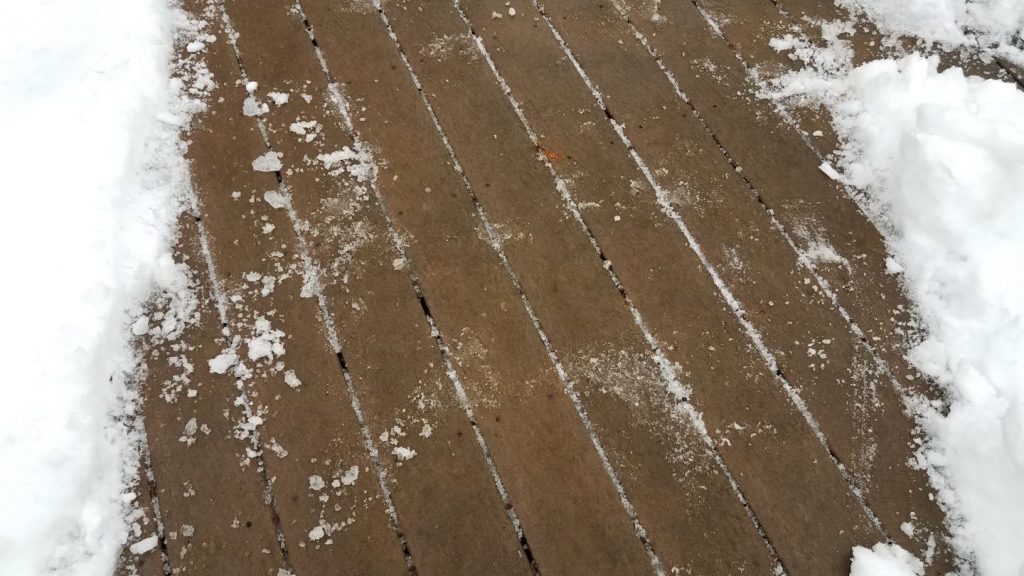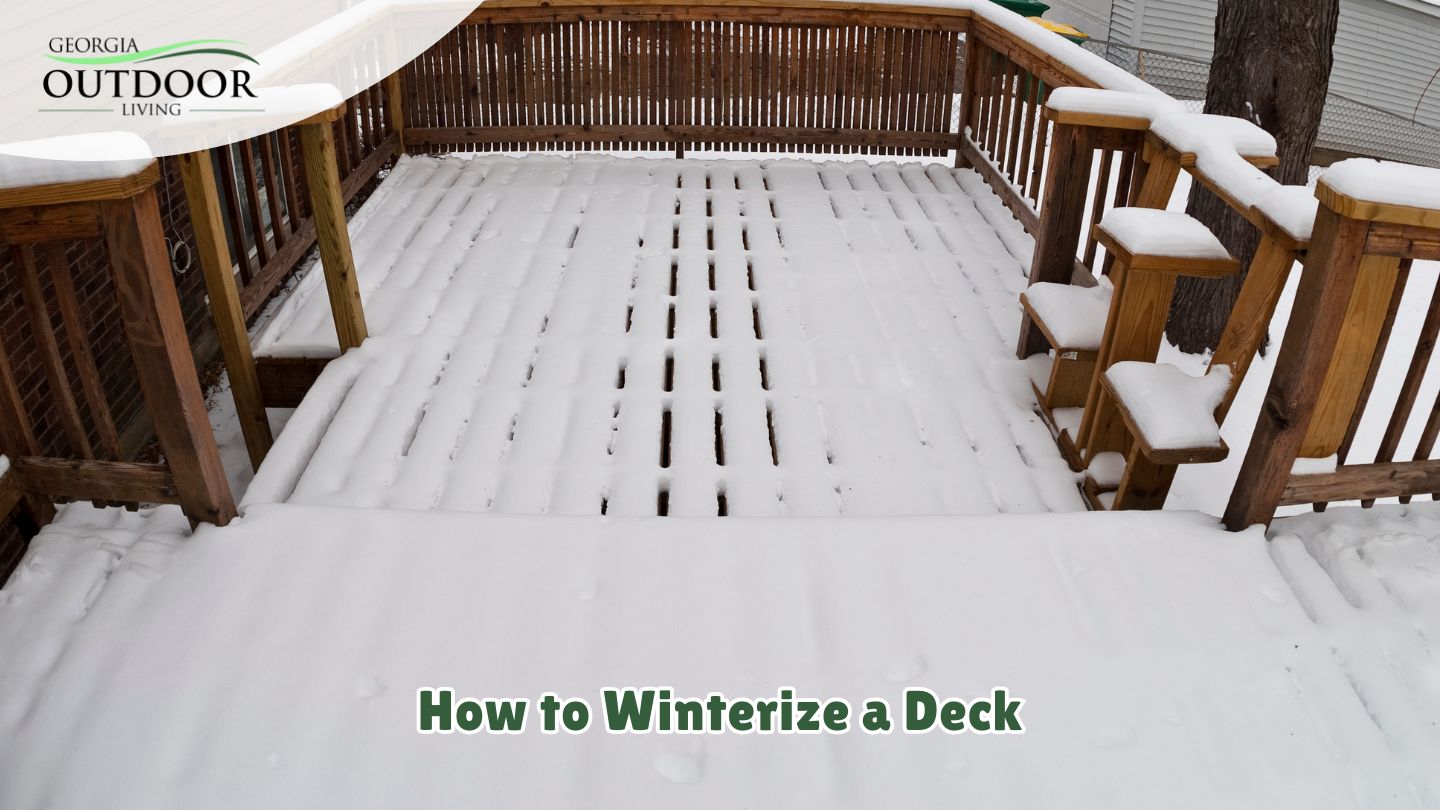Winterizing your deck is essential to prevent damage from cold, snow, and ice. In this blog, you’ll learn clear, step-by-step instructions on how to winterize a deck. We’ll cover everything from cleaning and inspecting for damage to sealing and protecting your deck so it remains in great condition through winter.
Key Takeaways
Clearing debris, trimming branches, and thoroughly cleaning are essential steps to prevent moisture buildup and damage during winter.
Professional inspecting and repairing any deck damage before winter, along with performing a water test, ensures the structural integrity and proper sealing of the deck.
Using deck covers, regularly removing snow, and considering composite decking can enhance deck longevity and reduce maintenance during harsh winter conditions.
Clear Debris and Dirt
To adequately prepare your deck for winter, begin by hiring professional deck services to remove all accumulated debris and soil from the deck surface. Undertaking this task is vital to prevent moisture from building up and fostering mold growth, which can cause significant damage over time. The professionals will use a broom or leaf blower to sweep away leaves, dirt, and other debris that may have been collected on your deck. This ensures that the surface of your deck remains clean and devoid of materials that might hold in moisture—a key step when it comes to effectively winterizing your outdoor space.
For a deeper cleaning of your deck’s surface, utilizing professional deck services with a power washer can be extremely beneficial. The forceful stream of water provided by power washing is adept at eliminating stubborn stains as well as any lingering dirt with great efficiency. By doing so, not only are you cleaning the surface but also preparing it meticulously for additional measures required in its winterization process—leaving no doubt that it’s absolutely dry.
Trim Overhanging Branches

It’s crucial to cut back any large branches that overhang your deck as part of its winter preparation. The weight from accumulating snow and ice during the winter months may cause these branches to snap, posing a threat of damage to your deck. By pruning them, you not only prevent potential harm but also decrease the volume of debris that can fall into the space.
Keeping an unobstructed area above your deck is beneficial for maintaining structural integrity and preventing moisture and entrapment, which could foster mildew growth. Effective winterization of your deck is supported by this action, simplifying both snow removal tasks and clearing away accumulated debris.
Clean Your Deck Surface
After removing all debris and cutting back any overhanging branches, proceed to meticulously clean the surface of your deck. Power washing techniques are a highly efficient approach for eradicating stains and mildew in the area.
Before applying sealant to your deck, it is essential to perform an exhaustive cleaning. This guarantees that the sealant will bond correctly with the surface while offering optimal defense against weather conditions. Not only does this practice help preserve the aesthetic appeal of your decking area, but it also extends its serviceable life.
Inspect and Repair Damage
Before applying a sealant, conducting an examination of your deck for any indications of harm is crucial. Keep an eye out for any loose screws or boards, as well as additional symptoms of deterioration. This precaution ensures that the safety and structural soundness of remains remains intact.
During this assessment phase, be sure to scrutinize for any planks that are broken or exhibit cracks. Also, look for traces of mold, mildew, and wood rot. Pools of water accumulating in certain spots could suggest the need to replace some boards. Attending to these matters promptly can help you avoid more expensive repairs later on.
Securing all apparent damages before entering the winter season is paramount due to its significance. Harsh weather conditions throughout winter, particularly when it’s cold and wet, can intensify pre-existing defects, which may result in major concerns such as structural damage over time. Maintaining routine inspections over the course of winter allows you to detect fresh damage soon after it appears.
Store Outdoor Furniture and Planters

Securing your outdoor furniture and clearing your deck before winter sets in is crucial for safeguarding both. Ensure that every piece of furniture, planter, and any accumulated debris are removed from the deck to avert problems such as mildew growth, discoloration, or decay due to moisture retention.
Prioritize cleaning all of your outdoor furnishings and containers meticulously before relocating them into storage space. This action shields them against the harshness of winter weather while also preparing them for immediate use once the climate shifts back to warmer conditions. A multitude of homeowners have observed that taking these precautions greatly contributes to extending their deck’s durability and improving the overall aesthetic quality of their outdoor living areas.
Elevate Planters
Raising planters off the deck surface is a straightforward and efficient method to safeguard your deck against moisture-related harm. By employing bricks or wooden blocks to elevate your planters, you prevent stagnant water from accumulating beneath them. This act aids in preserving the quality of the deck surface by reducing decay and growth of mildew.
While elevating planters keeps plants safe, it also ensures that your deck stays well-maintained during winter months. Taking this minor measure can greatly enhance both the durability and aesthetic appeal of your deck.
Use Deck Covers or Tarps
Employing tarps or deck covers can act as a formidable barrier for your deck against the inclement conditions of winter, particularly from accumulations of snow and stray debris. These protective measures are vital in shielding your decking from the severe impact of ice and snow during colder months.
It is important to opt for a cover or tarp that facilitates adequate airflow to hinder mold and mildew proliferation. Such sturdy coverage acts as an additional safeguard, ensuring that your deck remains pristine despite exposure to tough winter weather scenarios.
Regular Snow and Ice Removal

To protect your deck from potential damage, it’s essential to keep snow and ice away. Use a plastic snow shovel or a broom with soft bristles to gently clear snow from the deck surface. Avoid metal shovels, as they can scratch or damage the decking.
It is important to consistently remove debris as accumulated ice can exert pressure that may result in damage to the structure of the deck. Neglecting to promptly eliminate piled-up snow can invite moisture-related deterioration. Establish a routine practice for timely removal.
When dealing with winter conditions and managing buildups of ice and snow during these colder months, select milder de-icing solutions rather than harsh chemicals that might compromise wood or composite decking materials. Such choices enable effective control while keeping your deck unharmed by corrosive agents.
Consider Composite Decking
Opt for composite decking if your aim is to find a substitute that requires less upkeep than wood or other composite materials. The resilience of composite decking means it remains unscathed by severe weather fluctuations, effectively resisting distortions such as warping, splitting, and cracking — ideal traits to minimize maintenance during the winter season.
With traditional wood decks, composite decking endures longer and resists common problems like insect invasions and water damage. Their care chiefly consists of straightforward activities like sweeping or hosing down, tasks which are effortless even during the cold months. Selecting these durable composites leads to significant savings in time spent on cleaning and overall maintenance when contrasted with conventional wooden structures.
Wrapping Up
To prepare your deck for the winter, it’s important to undertake key tasks such as removing debris, cutting back branches that may be extending over the area, applying sealant protection, and relocating outdoor furniture. These steps are fundamental in shielding your deck from severe winter conditions and preserving its durability.
Putting time into winterizing your deck can save you from costly repairs while keeping your outdoor living space looking good and useful. If you need help, consider hiring a deck contractor in Milton from Georgia Outdoor Living to ensure your outdoor spaces stay in great shape all year round. Contact us today to transform your deck into a winter-ready haven!
Frequently Asked Questions
Why is it important to clear debris and dirt from my deck before winter?
It is crucial to clear debris and dirt from your deck before winter to prevent moisture buildup and mold growth, which can cause significant damage over time.
Taking this preventive step helps maintain the integrity and longevity of your deck.
Why should I consider composite decking?
Composite decking is a durable, low-maintenance option that can withstand extreme weather while outlasting traditional wood.
Consider it for a long-lasting and hassle-free outdoor space.



